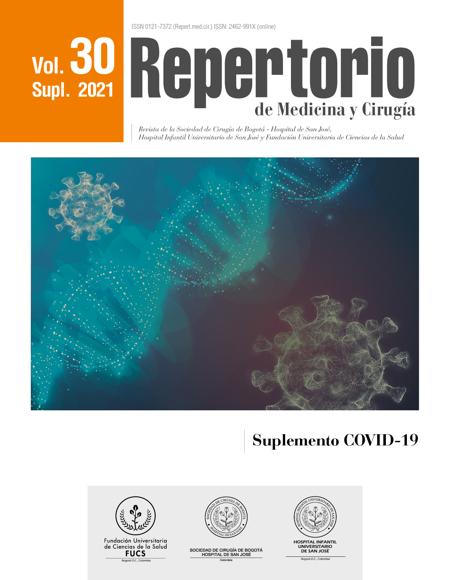Dynamics and relationsip of COVID-19 infection after SARS-COV-2 vaccination plan rollout in Colombia
Dinámica y relación del contagio del COVID-19 después de iniciado el plan de vacunación contra el SARS-COV-2 en Colombia
![]()
![]()

Show authors biography
Introduction: since the first cases of coronavirus disease 2019 (COVID-19) caused by acute respiratory syndrome coronavirus 2 (SARS-CoV-2) were identified in December 2019, the resulting pandemic has account for more than 130 million confirmed cases and more than 2.8 million deaths worldwide, as of April 6 2021. Objective: to show if there is a correlation between COVID-19 infections and SARS-COV-2 vaccination from February 17 to May 17 2021. Methodology: the information was obtained from the Ministry of Health and Social Protection website, based on COVID 19 infection and SARS-COV-2 vaccination daily reports for said period. Results: the p-value for the tests for COVID-19 infection and vaccination variables is 0.000, which is less than α =0.01, thus, the hypothesis (Ha) is accepted, which means that the Pearson correlation test indicates that there is a relationship between the number of COVID-19 infections and vaccination against SARS-COV-2 in Colombia. Conclusion: since vaccination against COVID-19 was started in mid-February 2021 in Colombia, there has been no evidence of a decrease in the number of COVID-19 infections. This study provides the first data in the country on how the SARS-COV-2 vaccine impacts the population.
Article visits 1651 | PDF visits 837
Downloads
- Gudbjartsson DF, Helgason A, Jonsson H, Magnusson OT, Melsted P, Norddahl GL. Spread of SARS-CoV-2 in the Icelandic Population. N Engl J Med. 2020;382(24):2302-2315. doi: 10.1056/NEJMoa2006100. DOI: https://doi.org/10.1056/NEJMoa2006100
- Huang C, Wang Y, Li X, Ren L, Zhao J, Hu Y, Zhang L, et al. Clinical features of patients infected with 2019 novel coronavirus in Wuhan, China. Lancet. 2020;395(10223):497-506. doi: 10.1016/S0140-6736(20)30183-5 DOI: https://doi.org/10.1016/S0140-6736(20)30183-5
- World Helath Organization. WHO Coronavirus (COVID-19) Dashboard [Internet]. World Helath Organization; 2021 [consultado 6 de abril 2021]; Disponible en: https://covid19.who.int/.
- Krammer F. SARS-CoV-2 vaccines in development. Nature. 2020;586(7830):516-527. doi: 10.1038/s41586-020-2798-3 DOI: https://doi.org/10.1038/s41586-020-2798-3
- Walsh EE, Frenck Jr RW, Falsey AR, Kitchin N, Absalon J, Gurtman A, et al. N Engl J Med. 2020;383(25):2439-2450. doi: 10.1056/NEJMoa202790 DOI: https://doi.org/10.1056/NEJMoa2027906
- Wang J, Peng Y, Xu H, Cui Z, Williams RO. The COVID-19 Vaccine Race: Challenges and Opportunities in Vaccine Formulation. AAPS PharmSciTech. 2020;21(6):225. doi: 10.1208/s12249-020-01744-7 DOI: https://doi.org/10.1208/s12249-020-01744-7
- Rawat K, Kumari P, Saha, L. COVID-19 vaccine: A recent update in pipeline vaccines, their design and development strategies. Eur J Pharmacol. 2021;892:173751. doi: 10.1016/j.ejphar.2020.173751 DOI: https://doi.org/10.1016/j.ejphar.2020.173751
- Abbasi K. Behavioural fatigue: a flawed idea central to a flawed pandemic response. BMJ. 2020;370:m3093. doi: 10.1136/bmj.m3093 DOI: https://doi.org/10.1136/bmj.m3093
- Rypdal K, Bianchi FM, Rypdal, M. Intervention Fatigue is the Primary Cause of Strong Secondary Waves in the COVID-19 Pandemic. Int J Environ Res Public Health. 2020;17(24):9592. doi: 10.3390/ijerph17249592 DOI: https://doi.org/10.3390/ijerph17249592
- Priesemann V, Brinkmann MM, Ciesek S, Cuschieri S, Czypionka T, et al. Calling for pan-European commitment for rapid and sustained reduction in SARS-CoV-2 infections. Lancet. 2021;397(10269):92-93. doi: 10.1016/S0140-6736(20)32625-8
- Priesemann V, Brinkmann MM, Ciesek S, Cuschieri S, Czypionka T, et al. Calling for pan-European commitment for rapid and sustained reduction in SARS-CoV-2 infections. Lancet. 2021;397(10269):92-93. doi: 10.1016/S0140-6736(20)32625-8 DOI: https://doi.org/10.1016/S0140-6736(20)32625-8
- Davies NG, Abbott S, Barnard RC, Jarvis CI, Kucharski AJ, et al. Estimated transmissibility and impact of SARS-CoV-2 lineage B.1.1.7 in England. Science. 2021;372(6538):eabg3055. doi: 10.1126/science.abg3055 DOI: https://doi.org/10.1126/science.abg3055
- Abbott S, Funk S, CMMID COVID-19 Working Group. Local area reproduction numbers and S-gene target failure [Internet]. Centre for Mathematical Modelling of Infectious Diseases 2021. [Citado 10 de junio de 2021]; Disponible en: https://cmmid.github.io/topics/covid19/local-r-sgtf.html
- Horby P, Huntley C, Davies N, Edmunds J, Ferguson N, Medley G, Semple C. NERVTAG paper on COVID-19 variant of concern B.1.1.7. Department of Health and Social Care. [Citado 10 de junio de 2021]; Disponible en: https://www.gov.uk/government/publications/nervtag-paper-on-covid-19-variant-of-concern-b117
- Bubar KM, Reinholt K, Kissler SM, Lipsitch M, Cobey S, Grad YH. Model-informed COVID-19 vaccine prioritization strategies by age and serostatus. Science. 2021;371(6532):916–921. doi: 10.1126/science.abe6959 DOI: https://doi.org/10.1126/science.abe6959
- Ramos AM, Vela-Pérez M, Ferrández MR, Kubik AB, Ivorra B. Modeling the impact of SARS-CoV-2 variants and vaccines on the spread of COVID-19. Preprint in ResearchGate. [Citado 10 de junio de 2021]; Disponible en: https://doi.org/10.13140/RG.2.2.32580.24967/2
- Suárez-Ibujes M. Coeficiente de correlación de Karl Pearson [Internet]. 2021. [citado 14 mayo 2021]; Disponible en: https://www.monografias.com/trabajos85/coeficiente-correlacion-karl-pearson/coeficiente-correlacion-karl-pearson.shtml
- Díaz-Pinzón JE. Estudio de los resultados del contagio por COVID-19 a nivel mundial. Repert Med Cir. 2020;29 (Núm. Supl.1):65-71. doi: 10.31260/RepertMedCir.01217372.1089 DOI: https://doi.org/10.31260/RepertMedCir.01217372.1089
- Díaz-Pinzón, J.E. Proyección del COVID-19 en Colombia. Rev. Med. [Internet]. 11 de septiembre de 2020 [citado 19 de abril de 2021]; 28(1). DOI: https://doi.org/10.18359/rmed.4702 DOI: https://doi.org/10.18359/rmed.4702
- Díaz-Pinzón, J.E. Soporte técnico de simulación Phet en la enseñanza y aprendizaje de fracciones equivalentes. RIUQ. 2016;28(2):31-41. doi: https://doi.org/10.33975/riuq.vol28n2.6 DOI: https://doi.org/10.33975/riuq.vol28n2.6













